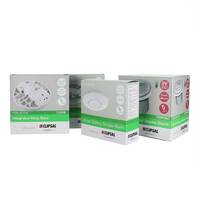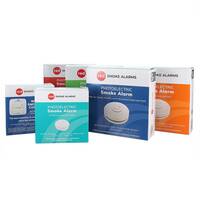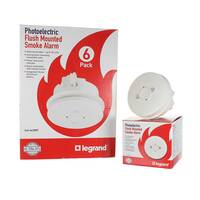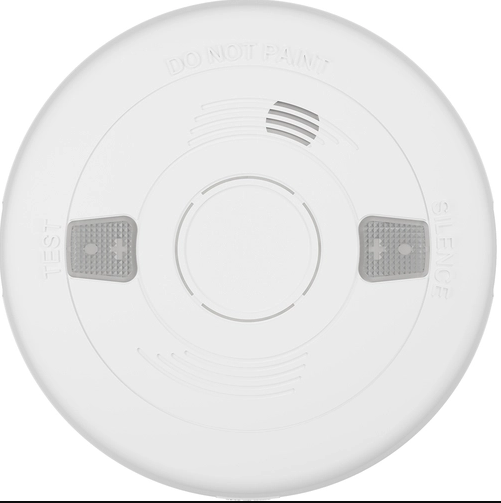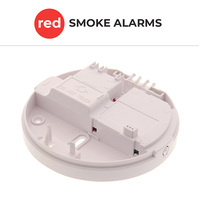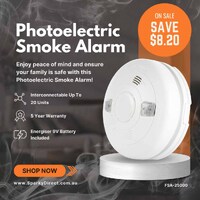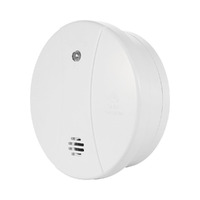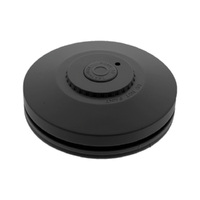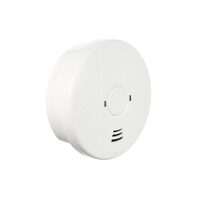Smoke Alarm
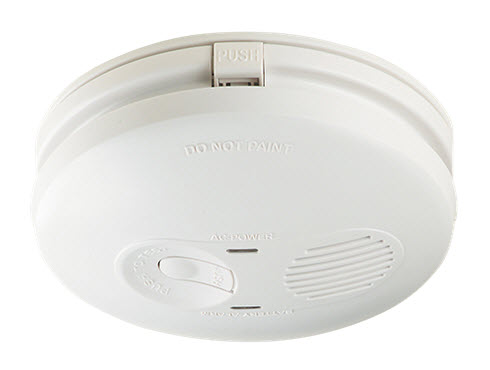
Learn more by watching our Smoke Alarm video
Smoke Alarm: A detailed guide all about smoke alarms
No one wants to wake up to the sound of a smoke alarm blaring in the middle of the night, but it's essential to keep your home smoke-free in case of an emergency. Here's everything you need to know about smoke alarms and how to keep them working correctly.
A smoke alarm is a device that detects smoke and sounds an alarm to alert people of the fire in homes, offices and public buildings.
What is a Smoke Alarm?
A smoke alarm is a small, 240V mains powered device with battery backup or a solely battery-operated device that detects the presence of smoke and sounds an alarm to warn people of the fire. Smoke alarms should be installed in every room in your home, hallways that lead to bedrooms and every level or floor of the property.
How does a Smoke Alarm Work?
When a fire starts, hot gases and particles (smoke) rise into the air. These gases and particles are what a smoke alarm senses. Smoke alarms work by sounding an alarm when they detect abnormal levels of smoke.
Two types of Smoke Alarm
There are two main types of smoke alarms: ionisation smoke alarms and photoelectric smoke alarms.
Ionisation smoke alarms use a technology called ionisation to detect smoke. When particles in the air become ionised (charged), they create an electric field. This electric field is what the alarm senses and triggers the alarm.
All Ionisation smoke alarms should be phased out in favour of photoelectric alarms.
Photoelectric alarms use a sensor to see the light. Smoke can interfere with the sensor's ability to see the light, which causes the alarm to sound—the best type of smoke alarm for smouldering fires. Photoelectric smoke alarms detect visible particles of combustion, e.g. smouldering cigarette smoke. They respond to a wide range of fires, but they are exceptionally responsive to smouldering fires and the dense smoke given off by foam-filled furnishings or overheated PVC wiring.
How do you tell if you have an Ionisation smoke alarm?
Look for a radiation symbol near the battery compartment. Photoelectric smoke alarms do not have this symbol.
How often should a Smoke Alarm be tested in Australia?
Ideally, smoke alarms should be checked for correct operation at least once a month, with the batteries replaced yearly if they are not the lithium 10-year battery type. Rental properties are tested for correct operation every six months. See below for legislation in different states.
How do you replace the smoke alarm batteries?
Remove the smoke alarm from its base; please check with the manufactures instructions on how to do this. Once removed, there will be a section that houses the battery. Remove the battery and install a fresh in-date 9v battery.
Replace the smoke alarm with the base and test the alarm by pressing the test button.
Testing a smoke alarm is easy - all smoke alarms have a test button on them - press this button until it sounds. If it does not sound, check to see if the power is connected via the alarm indicator, replace the battery, and test again.
Test smoke is also available to simulate a smouldering fire.
Do you sell Red Smoke Alarms?
Yes - you can find the complete range of RED Smoke Alarms online at Sparky Direct
Smoke Alarm Controller
The convenient way to stop smoke alarms from sounding or to locate which alarm has sounded first
Red smoke alarms provide two wall controller options - Hardwired RAC240 and Wireless RAC.
PSA has the LIF6000THL wall controller.
Reasons to install a working Smoke Alarm
- 57% more likely that property damage will occur when there is no working smoke alarm.
- 26% more likely that serious injury will occur when there is no working smoke alarm.
- 4 x More likely that there will be a fatality when there is no working smoke alarm.
Source: Queensland Fire and Emergency Service statistics on residential house fires.
Frequently Asked Questions
Which smoke alarm is best?
Sparky Direct sells only quality smoke alarms that have been tested to Australian standards and are preferred by electricians.
- Clipsal smoke alarms offer a 5-year In house warranty
- Red smoke alarms offer a 10-year in house warranty
- PSA smoke alarms offer a 5-year return to the supplier warranty
How do you Interconnected photoelectric smoke alarms?
Interconnected smoke alarms are alarms that are hardwired or connected with wireless technology. Interconnected smoke alarms, when activated, ensure that all alarms sound on the property.
Properties can have a mixture of hardwired interconnected and wireless alarms - simply by adding a wireless base to the installation. Wireless bases are available as Clipsal, RED smoke alarms, and PSA wireless bases.
Important note - never mix and match brands - always install the same brand throughout the installation to maintain system integrity.
How to stop a sounding smoke alarm?
The best way to stop a sounding alarm is to install a wall controller. This means you don't have to run around with a ladder or broomstick trying to hush all the alarms until you find the alarm at fault.
Smoke Alarm Controller Brands
Red Smoke Alarms provide two wall controller options - Hardwired RAC240 and Wireless RAC.
PSA has the LIF6000THL wall controller.
Why does my smoke alarm beep?
Low batteries are the most common reason smoke detectors beep when there is no smoke or fire. As the battery weakens, the device will beep regularly to let you know it's time to replace it. You may also find that smoke alarms beep early morning when the temperature drops. This happens because the battery is cold, and if the voltage is already low in the battery, it may drop a percentage below the desired working range, causing the alarm to sound.
When it's really cold outside, or if somebody opens a door adjacent to a warm area, the smoke alarm may go off. This is because there's water vapour in the sensor, and when that happens, it sets off the alarm.
How to install a Smoke alarm
Installers use the following fixings to mount the smoke alarm to the different surfaces.
- Screws
- Wall Mates and screws
- Green Plugs
- All Wall anchors - screw and fixing in one
- Fastners and anchors
Rental Property Smoke Alarm Legislation around Australia
(This is a guide only, legislations may have changed after publication on 11/4/22- Please check with local authorities and have all 240v smoke alarms installed by a qualified electrician)
Queensland
In Queensland, the Fire and Emergencies Act 1990 requires smoke alarms are installed in all domestic dwellings. It is the landlord's responsibility to ensure smoke alarms are in working order and meet the requirements of Australian Standard 3786 and must be cleaned and have the batteries changed within 30 days of a new tenancy agreement or lease renewal.
Smoke alarms must also be installed in compliant locations as deemed by the Building Code of Australia Part 3.7.2. From 1 January 2022, any property in Queensland that is sold, has a lease renewal or change of tenancy must comply with the new legislation.
A Queensland smoke alarm must be:
- Photoelectric and interconnected
- Compliant with AS3786:2014
- Installed on each storey of the property and in all bedrooms and hallways
- Interconnect so all activate when one alarm activates
- Powered by mains power or a non-removable 10-year battery
- Alarms must not be older than ten years
NSW
It is the landlord's responsibility to make sure smoke alarms are in working order and meet the requirements of Australian Standard 3786. Smoke alarms must be placed in accordance with the Building Code of Australia Part 3.7.2.
Standard residential requirements
As of September 2020, in NSW, it is a requirement that a landlord must:
- Service smoke alarms annually.
- Ensure all smoke alarms are functioning at all times.
- Replace alarms within their 10-year expiry period.
- Install or replace (or engage a person to install or replace) all removable batteries in all smoke alarms annually.
- Provide a smoke alarms & batteries condition report to the real estate agency – required in the tenancy agreement before the tenant moves in.
- Smoke alarms are legally required in buildings where persons sleep.
ACT
The Residential Tenancies Act 1997 mandates that photoelectric smoke alarms must be installed and maintained in properties where people sleep.
It is the responsibility of landlords to ensure proper installation, testing and maintenance occur within the property.
In addition to legislation, smoke alarms within properties must also comply with the Building Code of Australia 3.7.2.
- All smoke alarms must be serviced annually.
- Smoke alarms should be checked before the commencement of a new tenancy, and at a bare minimum, new batteries should be installed.
- After the commencement of the lease, tenants are responsible for changing batteries but ONLY in battery-powered alarms (not including 10-year lithium battery alarms).
- Tenants must notify landlords if the smoke alarm is not functioning correctly.
VIC
As of 29 March 2021, it is the law that a residential rental provider must ensure that smoke alarms are in working order and meet AS3786 and are installed as set out in BCA 3.7.2
- Every smoke alarm must be tested at least once every 12 months as per the manufacturer's instructions.
- Any broken or faulty smoke alarms must be Immediately repaired or replaced.
- The batteries in each smoke alarm must be tested and replaced as required on or before the commencement of the residential rental agreement.
- The residential rental provider must provide all new tenants with smoke alarm information, how smoke alarms work, how to test them and detail the tenant's obligations to not tamper with alarms. This notification must occur on or before the commencement of the residential rental agreement.
WA
The Building Regulations 2012 requires smoke alarms to be installed and are in working order before starting a residential tenancy agreement.
Smoke alarms must be
- Connected to mains power
- Less than ten years old
- Installed in compliant locations as set out in the Building Code of Australia Part 3.7.2
- Tested regularly.
Landlords are responsible for the ongoing maintenance of smoke alarms:
Landlords have a contractual obligation to provide working and compliant smoke alarms, and Landlords can't enter into a tenancy agreement unless the property complies. The tenants must notify landlords if the smoke alarm is not functioning correctly so it can be replaced or made compliant.
Sparky Direct -News Flash - We have the latest compliant AS3786:2014 Photoelectric Smoke alarms -
View our extensive range at excellent prices and shop online for nationwide delivery and Save! If you're after a Smoke detector, 9v battery-operated, smoke in a can. Smoke detector with 240v battery back up look no further.


